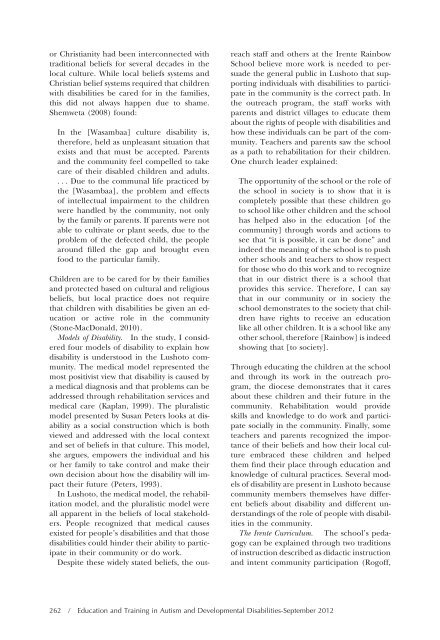etadd_47(3) - Division on Autism and Developmental Disabilities
etadd_47(3) - Division on Autism and Developmental Disabilities
etadd_47(3) - Division on Autism and Developmental Disabilities
You also want an ePaper? Increase the reach of your titles
YUMPU automatically turns print PDFs into web optimized ePapers that Google loves.
or Christianity had been interc<strong>on</strong>nected with<br />
traditi<strong>on</strong>al beliefs for several decades in the<br />
local culture. While local beliefs systems <strong>and</strong><br />
Christian belief systems required that children<br />
with disabilities be cared for in the families,<br />
this did not always happen due to shame.<br />
Shemweta (2008) found:<br />
In the [Wasambaa] culture disability is,<br />
therefore, held as unpleasant situati<strong>on</strong> that<br />
exists <strong>and</strong> that must be accepted. Parents<br />
<strong>and</strong> the community feel compelled to take<br />
care of their disabled children <strong>and</strong> adults.<br />
. . . Due to the communal life practiced by<br />
the [Wasambaa], the problem <strong>and</strong> effects<br />
of intellectual impairment to the children<br />
were h<strong>and</strong>led by the community, not <strong>on</strong>ly<br />
by the family or parents. If parents were not<br />
able to cultivate or plant seeds, due to the<br />
problem of the defected child, the people<br />
around filled the gap <strong>and</strong> brought even<br />
food to the particular family.<br />
Children are to be cared for by their families<br />
<strong>and</strong> protected based <strong>on</strong> cultural <strong>and</strong> religious<br />
beliefs, but local practice does not require<br />
that children with disabilities be given an educati<strong>on</strong><br />
or active role in the community<br />
(St<strong>on</strong>e-MacD<strong>on</strong>ald, 2010).<br />
Models of Disability. In the study, I c<strong>on</strong>sidered<br />
four models of disability to explain how<br />
disability is understood in the Lushoto community.<br />
The medical model represented the<br />
most positivist view that disability is caused by<br />
a medical diagnosis <strong>and</strong> that problems can be<br />
addressed through rehabilitati<strong>on</strong> services <strong>and</strong><br />
medical care (Kaplan, 1999). The pluralistic<br />
model presented by Susan Peters looks at disability<br />
as a social c<strong>on</strong>structi<strong>on</strong> which is both<br />
viewed <strong>and</strong> addressed with the local c<strong>on</strong>text<br />
<strong>and</strong> set of beliefs in that culture. This model,<br />
she argues, empowers the individual <strong>and</strong> his<br />
or her family to take c<strong>on</strong>trol <strong>and</strong> make their<br />
own decisi<strong>on</strong> about how the disability will impact<br />
their future (Peters, 1993).<br />
In Lushoto, the medical model, the rehabilitati<strong>on</strong><br />
model, <strong>and</strong> the pluralistic model were<br />
all apparent in the beliefs of local stakeholders.<br />
People recognized that medical causes<br />
existed for people’s disabilities <strong>and</strong> that those<br />
disabilities could hinder their ability to participate<br />
in their community or do work.<br />
Despite these widely stated beliefs, the out-<br />
reach staff <strong>and</strong> others at the Irente Rainbow<br />
School believe more work is needed to persuade<br />
the general public in Lushoto that supporting<br />
individuals with disabilities to participate<br />
in the community is the correct path. In<br />
the outreach program, the staff works with<br />
parents <strong>and</strong> district villages to educate them<br />
about the rights of people with disabilities <strong>and</strong><br />
how these individuals can be part of the community.<br />
Teachers <strong>and</strong> parents saw the school<br />
as a path to rehabilitati<strong>on</strong> for their children.<br />
One church leader explained:<br />
The opportunity of the school or the role of<br />
the school in society is to show that it is<br />
completely possible that these children go<br />
to school like other children <strong>and</strong> the school<br />
has helped also in the educati<strong>on</strong> [of the<br />
community] through words <strong>and</strong> acti<strong>on</strong>s to<br />
see that “it is possible, it can be d<strong>on</strong>e” <strong>and</strong><br />
indeed the meaning of the school is to push<br />
other schools <strong>and</strong> teachers to show respect<br />
for those who do this work <strong>and</strong> to recognize<br />
that in our district there is a school that<br />
provides this service. Therefore, I can say<br />
that in our community or in society the<br />
school dem<strong>on</strong>strates to the society that children<br />
have rights to receive an educati<strong>on</strong><br />
like all other children. It is a school like any<br />
other school, therefore [Rainbow] is indeed<br />
showing that [to society].<br />
Through educating the children at the school<br />
<strong>and</strong> through its work in the outreach program,<br />
the diocese dem<strong>on</strong>strates that it cares<br />
about these children <strong>and</strong> their future in the<br />
community. Rehabilitati<strong>on</strong> would provide<br />
skills <strong>and</strong> knowledge to do work <strong>and</strong> participate<br />
socially in the community. Finally, some<br />
teachers <strong>and</strong> parents recognized the importance<br />
of their beliefs <strong>and</strong> how their local culture<br />
embraced these children <strong>and</strong> helped<br />
them find their place through educati<strong>on</strong> <strong>and</strong><br />
knowledge of cultural practices. Several models<br />
of disability are present in Lushoto because<br />
community members themselves have different<br />
beliefs about disability <strong>and</strong> different underst<strong>and</strong>ings<br />
of the role of people with disabilities<br />
in the community.<br />
The Irente Curriculum. The school’s pedagogy<br />
can be explained through two traditi<strong>on</strong>s<br />
of instructi<strong>on</strong> described as didactic instructi<strong>on</strong><br />
<strong>and</strong> intent community participati<strong>on</strong> (Rogoff,<br />
262 / Educati<strong>on</strong> <strong>and</strong> Training in <strong>Autism</strong> <strong>and</strong> <strong>Developmental</strong> <strong>Disabilities</strong>-September 2012

















